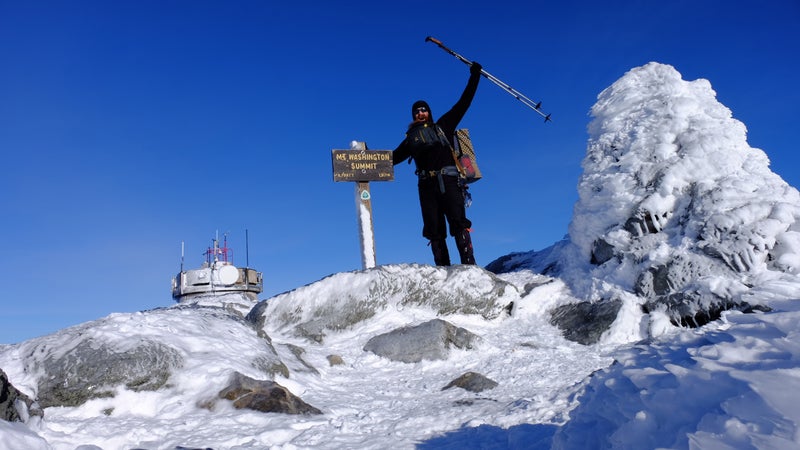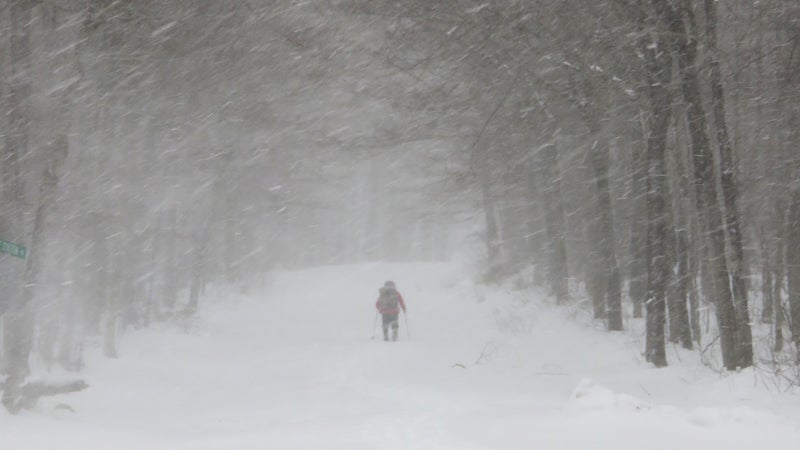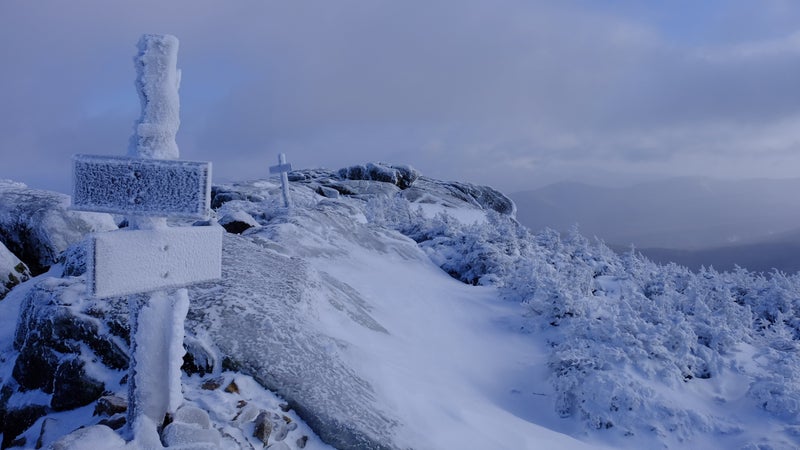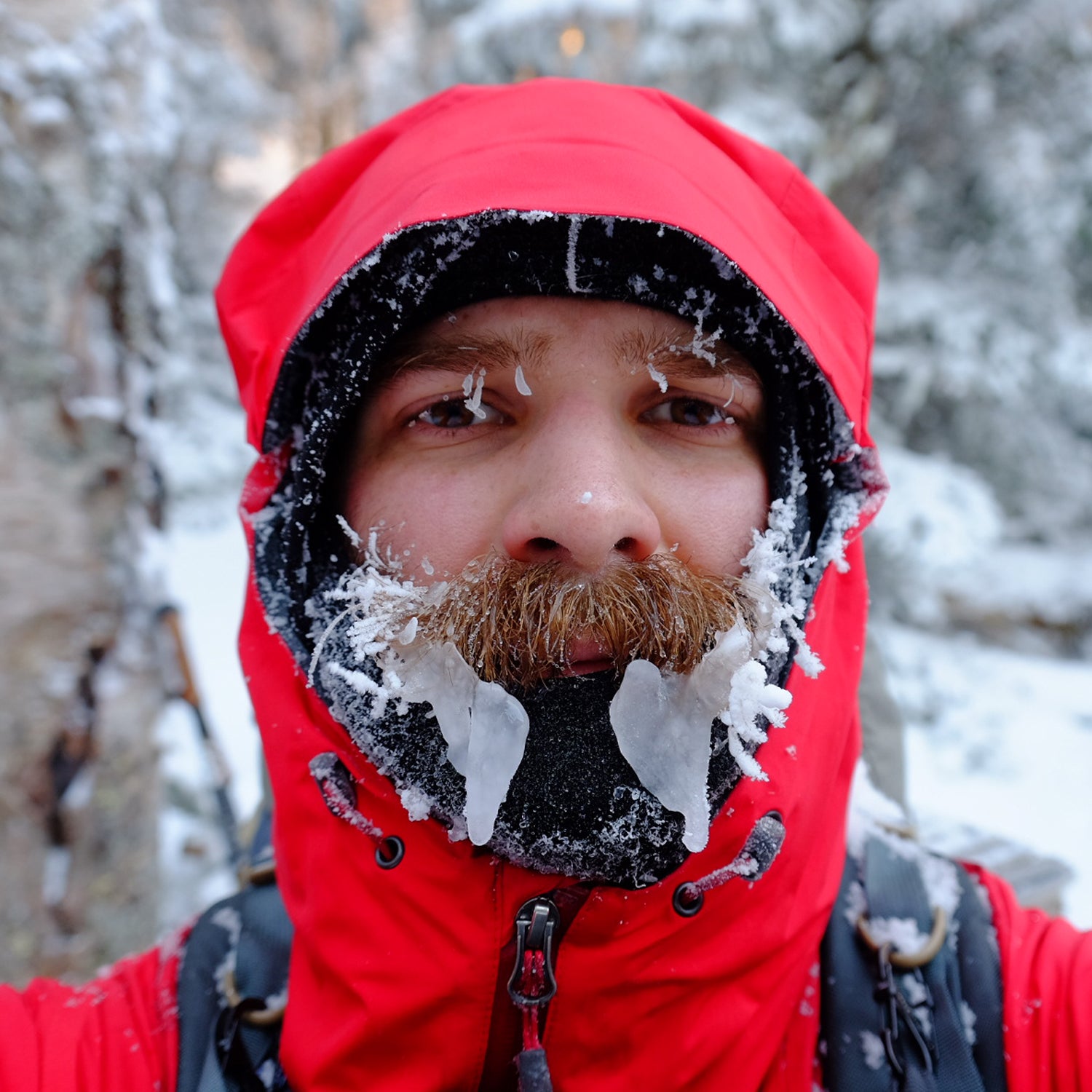Before sunrise one morning in mid-December, two weeks into his winter attempt to thru-hike the Appalachian Trail, Thomas Gathman marched toward two of Mount Bigelow’s craggy peaks in western Maine as a snowstorm descended. By the time he’d bagged the first one, 4,088-foot Avery Peak, he was trudging through a foot of new fallen snow.
As Gathman stumbled across the adjacent, exposed ridge of the 4,145-foot West Peak, he faced whiteout conditions, with the temperature dropping to -20 degrees and wind gusting up to 70 mph. Gathman’s face mask was tucked securely in his pack and stopping to put it on would take time, so he pushed ahead, vying to reach the cover of trees before frostbite set in.
“I was fully, totally exerting myself for each individual step just to push through the wind,” Gathman said on a phone call with �����ԹϺ��� in January as he resupplied near Hanover, New Hampshire, 200 miles south of Mount Bigelow. “I could feel the stinging sensation starting and turning into numbness on the exposed skin on my cheeks and nose and near my eyes.” After suffering exposure on the ridge for nearly 10 minutes, Gathman escaped below the tree line into relative safety.
That harrowing experience was just one of countless hazards encountered by as he attempts to become the first person on record to complete a solo, southbound winter thru-hike of the AT, having started in December. On December 4, Gathman set out from the 100-Mile Wilderness in Maine. Many of the thousands of hikers who attempt the trail each year start at Springer Mountain in Georgia and head north during the spring thaw in March or April. A handful have left in December heading south but, according to the Appalachian Trail Conservancy’s records, no one has ever successfully finished.

By the end of January, Gathman had made it through New Hampshire’s White Mountains and into Vermont, having covered more than 500 of the most arduous miles along the 2,190-mile trail. That doesn’t mean the remaining 1,600 miles will be a walk in the park. Icy weather persists at the higher elevations until spring, especially in , where snowdrifts have been known to render parts of the trail impassible during the colder months.
“It’s exponentially more difficult” in winter, says Laurie Potteiger, Appalachian Trail Conservancy information services manager. “The stakes are higher, there’s no people around, it’s not the social experience. You don’t have camaraderie, you don’t have the assistance, you don’t have the moral support. Literally you’re dead if you don’t have experience.”
Gathman has logged nearly 10,000 miles along trails like the Continental Divide Trail, Arizona Trail, and the Pacific Crest Trail. But other than a day hike or two in snow, the 32-year-old Gathman has no extensive winter hiking experience at all. He did hike the AT in 2013—northbound, starting in spring, like typical thru-hikers. What knowledge he had of cold-season gear came from a few friends with winter mountaineering chops.
Ask Gathman why he's making the attempt given his experience and he’ll tell you that he has a deep desire to test his limits. He’s not out to claim a record or gain media attention. I'd reached out to him after hearing about his struggles through Maine. “There’s just something about setting and accomplishing goals every day and physically exerting myself,” he says. “It works for me on such a fundamental level that I’m at peace with it. It’s a simple way of living and it’s a pure way of living.”
Gathman grew up in Lewisburg, Pennsylvania, but if you ask him where he lives today, the answer will most likely depend on which trail he’s hiking. Gathman owns no home or vehicle, and is a full-time backpacker. He served in the U.S. Marine Corps, completing two tours in Iraq between 2007 and 2009.
Gathman got his trail name, “Jabba,” on his first AT hike, but he's more widely known as the Real Hiking Viking, a persona he created to share his story online. One look at Gathman and the moniker becomes clear: with his flowing hair and mangled beard, he looks a bit like Hagrid from the Harry Potter films.

“He just has a conviction and constitution about him,” says David Allen, who shared more than 700 miles with Gathman on a thru-hike of the CDT in 2014. “It’s almost like he’s doing something he finds absolute happiness with. I don’t think quitting is in his makeup.”
Ever the disciplinarian, Gathman has kept a simple but stringent routine on the Appalachian Trail. He wakes up before 4:30 a.m., packs his 35-pound backpack and is hiking before sunrise. He walks with the aid of crampons or snowshoes throughout the day without stopping much. “It’s literally climbing over boulders and clinging to trees—wearing crampons the entire day,” he says. “It’s just up and down and rugged over major rock and real steep ups and downs.”
Snacks like beef sticks and almonds go in his pockets both to keep them from freezing and so he can easily eat them on the go. Preventing his water from freezing, as well as finding flowing water sources, is a constant battle. He keeps his Nalgenes in neoprene koozies or boils water as he refills to ward of freezing as long as he can. Staying dry is also tough, and when you’re sweating in subzero temperatures, pausing on the trail can cause your core temperature to drop rapidly, so Gathman tries to keep moving at all times.
On Gathman’s first day on the AT, he forded the 100-Mile Wilderness's Big Wilson Stream at night. It was swollen due to days of rain and snow, and Gathman took a slip and soaked his lower half and right arm. “Trying to keep your footing with completely numb legs, you can’t even really tell what’s going on under the water,” Gathman said. “I’m screaming bloody murder in the middle of the night, only being able to see my breath steaming out from underneath my headlamp, and just trying to safely get to the other side without going completely in. It was a couple miles before I could feel my feet again.”
Gathman has averaged around 15 miles a day, though he has surpassed 20 a handful of times. He hikes an hour or two past dark to ensure he makes his mileage goals for each day. While he carries a three-season tent, he opts to stay at the many shelters that dot the AT. It provides a quick option to escape the weather. At camp there’s no socializing or fire. Gathman quickly cooks a dehydrated meal on a canister stove and tucks into his bag.
“It’s a race to get into the sleeping bag,” he said. “My sleep system consists of a foam pad, an air pad, my down sleeping bag, a synthetic overquilt that goes over top of that. The synthetic overquilt traps all the condensation and moisture on top of it. Being that it’s synthetic, it still maintains its warming capabilities and saves my down from getting wet.”
Sweat-drenched, merino wool clothes go inside Gathman’s sleeping bag or else they’ll freeze in minutes. A combination of liner, neoprene, and wool socks worn in layers keep the inside of his leather, Gore-Tex-lined boots from getting wet most days, or they’ll have to be tucked in the bag at night, too, to ensure they don’t freeze.
“I’m either in motion or I’m pretty much about to get in my sleeping bag,” Gathman said. “Those are the only two ways that I exist in this world.”

Much of December was exceptionally mild and wet for New England standards, , with temperatures reaching well above average in the region. But in the higher elevations, there’s been no absence of inclement winter weather, especially in the 4,000-foot-plus peaks of the White Mountains and the Mahoosuc Range. Gathman goes into town to wait out the weather when he must, but every two to four days he’s off trail to resupply. In town he socializes and gets a dose of trail magic from locals; though on the trail, he’s seen less than a dozen day hikers so far and no overnight backpackers.
While a spring walk of the AT is a social activity, Gathman said his winter hike feels like a solitary wilderness experience, something that was absent during his first thru-hike. In front of him there’s only untouched snow. Behind him, the only footprints are his. He knows the seclusion won’t last forever, especially as he makes his way toward more densely populated sections farther south. But, for now, he's enjoying the rare experience of an uncrowded trail.
Due to missing his permit window back in December to climb Katahdin, if Gathman gets to Springer Mountain he’ll have to fly back to Maine to summit the northern terminus of the AT to officially say he thru-hiked. He said he should wrap up before May, just in time to finish the rest of the PCT this summer and earn a triple crown. But he knows he has a lot of cold, wet miles before then. So for now, he is keeping his mind focused on the present.
“I don’t think about Georgia,” he said. “I don’t even think about the next state. I think about literally what the next stretch is to the next resupply point. If everyday you feel like it’s going to be like walking on rainbows and dancing in sunshine you’re not going to make it. It’s rugged, it’s treacherous and it’s freezing. You have to fully accept it and that’s how you’re able to start appreciating it.”


